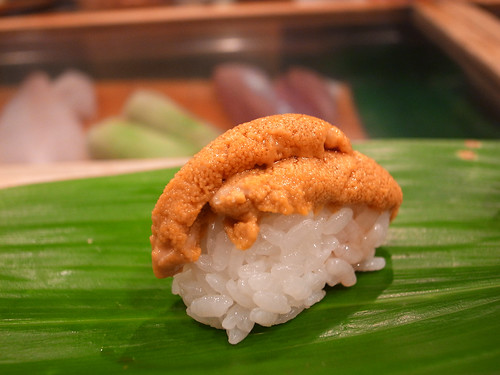
‘Sea Urchin’
courtesy of ‘aslives’
It’s that time of week when WeLoveDC brings you another edition to our ever growing list of DC Omnivore 100. For this entry, let’s push the envelope and go beyond personal food comfort levels by trying Sea Urchin.
If you’ve watched any Jacques Cousteau-esque nature shows, you know what a sea urchin looks like–a purplish-black, spiked, baseball sized creature attached to the ocean bottom or coral. And you know that stepping on them is a definite no-no. It’s also one of those peculiar food items, like lobster or snails, where some human was SO hungry and that he/she had no other option than taking on the time-consuming task of figuring out how/what parts of this creature they should/could eat.
Given the spiny, hard appearance of the sea urchin, it’s of no surprise that only a small portion of the creature, its roe (aka: gonads, ovaries, milt or eggs,) is edible. “Uni,” as the Japanese call the eatable part of the sea urchin, is considered a culinary delicacy in many parts of the world. Sea urchins are often eaten raw, with a squeeze of lemon or used to flavor omelets, soups and sauces, or used instead of butter.My experience with uni came at the Japanese restaurant Sushi Ko in Glover Park with my dad, who is the only fan of sea urchin I know and who eats it fairly regularly. His description, ” a creamy consistency with a slightly briny taste” sounded pretty good to this fan of fish roe (caviar) of all sizes. When the golden yellow sea urchin arrived it looked extremely palatable, and the combination of white rice and dark green seaweed made the dish look very appetizing. I know this isn’t an appealing way to describe how the texture of uni looks to the eye, but it looks like the taste bud riddled surface of your tongue. And don’t tell me you haven’t looked at your tongue in the mirror.
Then it came time for the tasting. The raw urchin carried a distinct, salty sweetness that was pleasing to a seafood lover, but the soft, mushy consistency left much to be desired. The flavor was exotic and new, but the carrying mechanism flawed. The urchin immediately broke apart in my mouth, in an almost mush-like way. To be fair there are varying qualities and grades of uni that determine the texture, and I’m not positive where my piece fell along the spectrum. For all I know, the uni that day was not of superior quality. I’m no uni-connoisseur.
The net of this DC Omni 100 is that after this first tasting I’m not sure I’m a sea urchin fan. It’s definitely an acquired taste and it’s not cheap. However, I haven’t written it off and I’m willing to give it another try. Perhaps I’ll wait until December, which is considered the best month for uni by Japanese standards, and maybe this time I’ll have it in an omelet or sauce, instead of whole hog sushi style.


Kaz Sushi Bistro also has excellent Urchin over a rice-pasta type thing, if someone is in search of them.
Pasta with sea urchin is popular in parts of Italy. I saw it in Sicily but was too squeamish to try it – not a fan of the mouth feel of uni so unsure what it would taste like with pasta.
Komi is currently featuring a pasta dish with urchin and crab… hmmm. Maybe it’s time to branch out.